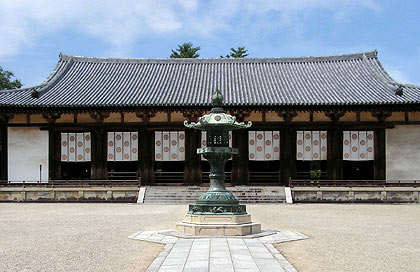|
||
 |
||

Houryuuji
Daikoudou 法隆寺大講堂 (Nara)
(C)2001 Japanese Architecture and Art Net Users System. No reproduction or republication without written permission.
掲載のテキスト・写真・イラストなど、全てのコンテンツの無断複製・転載を禁じます。
|
||||||
| daikoudou 大講堂 | ||||||
| KEY WORD : architecture / buildings & structures | ||||||
| Lit. large lecture hall. The lecture hall at Houryuuji 法隆寺, in Nara is the most famous and oldest extant daikoudou. The original hall was destroyed by fire in 925 and reconstruction was completed by 990. It was rebuilt on the same site with the same dimensions, but was only 8-bays in length until the medieval period, when aisles *hisashi 廂, were added to the west side making it 9×4 bays (33.78×13.52m). The original plan of the 10c rebuilding increased the width of the aisles surrounding the core *moya 母屋, thereby reducing the size of the moya. The earliest known use of a hidden roof *noyane 野屋根, first placed only over the hisashi, was discovered during dismantling repairs in the 1930s. The incline of the base rafters *jidaruki 地垂木, became less steep, thus permitting more light and air beneath the eaves while the pitch of the hidden rafters *nodaruki 野垂木, over the hisashi were made with a stronger incline to allow a fast run-off of rain. The Daikoudou at Houryuuji is behind the main hall *Kondou 金堂 and five-storied pagoda *Gojuu-no-tou 五重塔. The roofed, semi-enclosed corridor *Kairou 回廊, turns inward at the rear on each side. The sutra repository *Kyouzou 経蔵, and the belfry *Shourou 鐘楼, are contained within the continuing corridor which makes a 90 turn and is extended so that it reaches each side of the daikoudou Originally the corridor continued straight across the rear where it now turns inward. The daikoudou, kyouzou and shourou were all outside, and north of the main enclosure. Another example is the Enkyouji 円教寺 Daikoudou (1440), in Hyougo prefecture. It has a very different style from the Houryuuji Daikoudou or any typical lecture hall *Koudou 講堂. It is 2-storied, and is 7×6 bays (19.92×16.73m). The bracket complexes used in both stories are 2-stepped *futatesakigumi 二手先組, and the interstices between them have struts with bearing blocks *kentozuka 間斗束. The eaves are doubled on each story and the rafters are closely spaced *shigedaruki 繁垂木. The tiled roof is of the hip-and-gable type *irimoya-zukuri 入母屋造. The interior is like those used by Esoteric Budhism mikkyou 密教, with a 2-bay deep space for worshippers *raidou 礼堂, and a 4-bay deep space closed off by sliding doors. The core, is 5×2 bays but the actual sanctuary *naijin 内陣, is 3 ×2 bays with 1/4-size tiles spread over an earthen floor. The remaining area is covered with plank flooring. There is also a distinctive bracken wall behind the altar *shumidan 須弥壇. | ||||||
 Houryuuji
Daikoudou 法隆寺大講堂 (Nara)
|
||||||
| REFERENCES: | ||||||
| *garan haichi 伽藍配置 | ||||||
| EXTERNAL LINKS: | ||||||
| NOTES: | ||||||
(C)2001 Japanese Architecture and Art Net Users System. No reproduction or republication without written permission. 掲載のテキスト・写真・イラストなど、全てのコンテンツの無断複製・転載を禁じます。 |
||||||